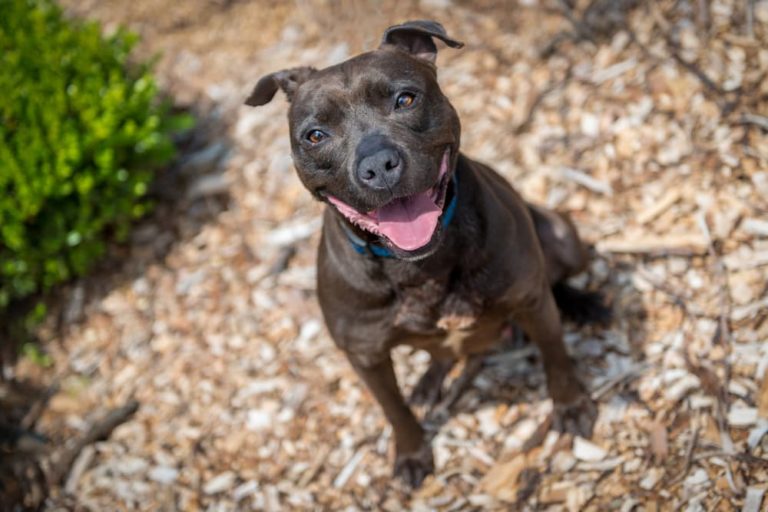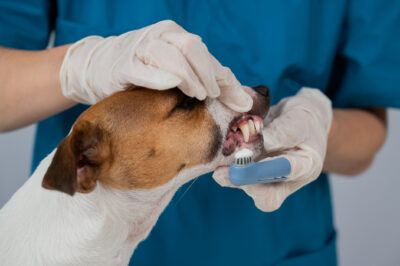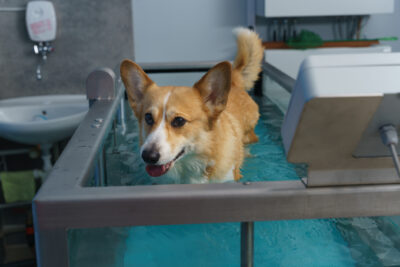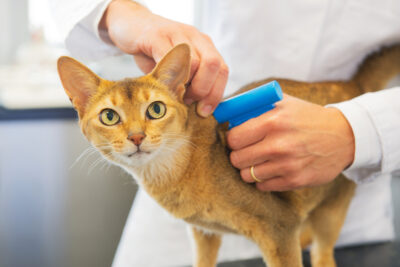Is Mulch Bad for Dogs?

A layer of fresh mulch can go a long way when it comes to sprucing up your garden and flower beds. But if you have a curious canine companion, you might be wondering if mulch is safe for dogs.
Mulch is often made from tree bark, wood chips, grass clippings, or other plant material. It is used to maintain soil moisture, reduce weeds, provide insulation, and make the landscaping prettier overall. While mulch can help improve your home’s curb appeal, it’s not good for your dog to munch on.
Keep reading to learn about some potential hazards of mulch for dogs, what types of mulch are safest, and what to do if your dog eats mulch.
Why Do Dogs Eat Mulch?

Dogs, especially puppies, tend to be curious of their surroundings and explore everything they can get their mouths on, including the earthy-smelling mulch you put down in your yard. Some dogs like to gnaw on wood mulch chips because they like the textured feel of it in their mouth. In other cases, dogs are simply bored and are looking for something fun to do.
Eating non-edible items like mulch is a form of pica. The condition is characterized by the compulsion to chew on and consume items like wood, bark, plastic, paper, or rocks. Pica can be seen in adolescent and adult dogs, and it can be caused by behavioral or medical problems. If your dog is bored, stressed, or anxious, he may opt to chew on mulch. Less commonly, pica may be caused by underlying medical conditions, such as anemia or mineral deficiencies.
Is Mulch Bad for Dogs?

Mulch, as it is, is not toxic to dogs if consumed in small amounts. However, eating too much mulch can cause an upset stomach, leading to vomiting and diarrhea, according to Dr. Patrik Holmboe, head veterinarian for Cooper Pet Care, a veterinary telemedicine provider in the Netherlands. Your dog could also choke on mulch.
“Ingesting large amounts of mulch (or even a single large, solid piece) can also lead to blockages in the dog’s gastrointestinal tract,” says Dr. Holmboe. Stomach blockages can be life-threatening and require immediate medical attention and, in some cases, surgery.
Some mulch could also contain mold or mushrooms that can be toxic to dogs. However, Holmboe says that risk is rather low compared to the risk of blockages.
Dog Eating Mulch: What to Do
If you see your dog bounding toward the garden, it’s best to try and stop him before he makes a picnic out of mulch. But if you catch your dog making an afternoon snack out of this multipurpose garden staple, or if you suspect your dog ate mulch when you weren’t looking, concerning signs to watch for include:
- Vomiting
- Diarrhea
- Abdominal pain
If you notice any of the above signs, seek veterinary help or use telehealth for immediate guidance, Dr. Holmboe says. “If the dog is acting fine, it is still important to keep an eye on any potential signs of illness,” he adds.
What Mulch Is Safe for Dogs?

If you are looking to add mulch to your yard, the best option is mulch made from natural wood. However, keep in mind that consuming any mulch can pose some risk to your canine, as it could cause stomach blockages and/or choking.
Wood-based mulch chips are made mainly from cedar (reddish brown in color), pine (dark brown), cypress (golden brown), and hemlock bark (reddish brown). These dog-friendly mulch materials are the safest bet to use in your yard.
Colored mulch, which typically comes in red and black, is made from wood chips that are dyed to be more attractive. Red mulch is colored with iron oxide and black mulch is colored with carbon black. This type of mulch is also deemed safe for pets, so long as it isn’t made from recycled pieces of wood. Recycled wood comes from demolition or construction sites and could contain chromated copper arsenate (CCA), which causes arsenic poison. For CCA-free mulch, look for the logo of the Mulch and Soil Council (MSC) on the packaging.
Is Cocoa Mulch Safe for Dogs?
Cocoa mulch is made with leftovers from chocolate production. While it looks beautiful and smells delicious, it could have the same impact on your dog as chocolate. This is because it contains low concentrations of theobromine, which is toxic to dogs. If ingested, it could cause vomiting and diarrhea, according to the American Animal Hospital Association. If large amounts are consumed, it could lead to muscle tremors or serious neurological problems, elevated heart rate, and even seizures, the ASPCA warns. If you are looking for a cocoa option for your garden, look for a product that has been tested and certified theobromine-free.
Is Rubber Mulch Safe for Dogs?
Rubber much is a durable option that is typically made from recycled tires. While it looks like wood, it’s not as fragrant, making your dog less likely to want to chew on it. However, it’s still best to keep your dog away from this type of mulch, as they are at risk of having an obstruction.
How to Stop Dogs from Eating Mulch

There is nothing positive about your dog chewing on mulch. If your dog is constantly going outdoors to grab a few pieces of mulch to gnaw on, Dr. Holmboe recommends the following tips:
Supervise your pet when he’s outside. It’s important to redirect your dog with the use of treats or basic training cues. If you haven’t taught your dog to “leave it” or “drop it,” these potentially lifesaving cues are worth adding to his repertoire.
Provide your dog with mental enrichment. As mentioned earlier, a dog eating mulch could be a sign of boredom. This can be addressed by providing more opportunities for stimulation, such as playing with chew toys or using food puzzles.
Fence off the area(s) where mulch is used. If your dog is persistent, you might try installing a dog-proof garden fence, such as those made of chicken wire. This is a sure-fire way to keep your dog out of trouble and away from mulch and any other plants that may be toxic to pets.









